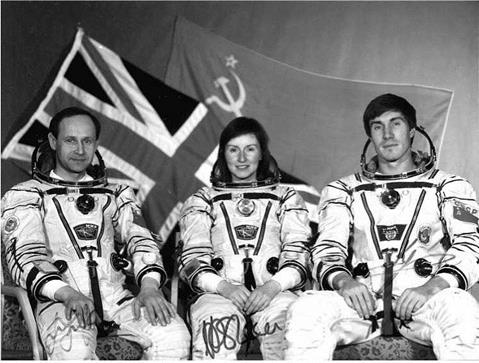SOYUZ TM12
|
Int. Designation |
1991-034A |
|
Launched |
18 May 1991 |
|
Launch Site |
Pad 1, Site 5, Baikonur Cosmodrome, Kazakhstan |
|
Landed |
10 October 1991 (Artsebarsky on TM12); 25 March 1992 (Krikalev on TM13); 26 May 1991 (Sharman on TM11) |
|
Landing Site |
67 km southeast of Arkalyk |
|
Launch Vehicle |
R7 (11A511U2); spacecraft serial number (7K-M) 062 |
|
Duration |
144 days 15hrs 21 min 50 sec (Artsebarsky); 311 days 20 hrs 1 min 54 sec (Krikalev); 7 days 21 hrs 14min 20 sec (Sharman) |
|
Call sign |
Ozon (Ozone) |
|
Objective |
Delivery of the 9th main crew to Mir and operation of UK Juno programme by Sharman |
Flight Crew
ARTSEBARSKY, Anatoly Pavolich, 34, Soviet Air Force, commander KRIKALEV, Sergei Konstantinovich. 32, civilian, flight engineer, 2nd mission Previous mission: Soyuz TM7 (1988)
SHARMAN, Helen Patricia, 27, civilian, UK cosmonaut researcher
Flight Log
The agreement to fly a UK citizen to a Soviet space station originated in 1986, but was not signed until 1989. Financial problems dogged the project but in November 1989, four finalists were named. Sharman was named as primary candidate in February 1991, with Major Tim Mace of the British Army as her back-up. During the docking with the Mir complex, erroneous readings were produced by the rendezvous equipment. Artsebarsky had to dock manually, while Sharman operated cameras from the Descent Module and Krikalev observed the docking from the forward window in the Orbital Module. After performing a week of experiments focusing on medical tests, physical and chemical research, as well as contacting nine British schools by radio, Sharman returned to Earth with the Mir EO-8 crew on TM11. The landing on TM11 was very hard, with the capsule rolling several times and resulting in disorientation and bruising to the crew inside.
The primary objective of the ninth main Mir crew (EO-9) involved a construction programme, with up to eight EVAs planned for their five-month tour aboard the station. Their first task, however, was to relocate TM12 from the front to the aft port to permit the arrival of Progress M8. This was followed by the release of a small minisatellite, MAK-1, from the experiment airlock in the base block. MAK-1 was designed
|
The Soyuz TM12 prime crew of Artsebarsky (left), Sharman and Krikalev |
to study Earth’s ionosphere, but a system failure rendered the satellite inoperable. The first of what turned out to be six EVAs by this crew (24 June, 4 hours 53 minutes) involved the removal and replacement of the failed Kurs approach system. EVA 2 (28 June, 3 hours 24 minutes) involved the deployment of the US-developed TREK device for studying cosmic rays. The other four EVAs (15 July, 5 hours 56 minutes; 19 July, 5 hours 28 minutes; 23 July, 5 hours 34 minutes and 27 July, 6 hours 49 minutes) focused on the construction of the Sofora girder structure. The crew deployed the Hammer and Sickle national flag of the USSR atop the girder during the sixth EVA, but Artsebarsky’s visor fogged up from his excursions during this EVA, requiring Krikalev to help him back to the hatch. The crew also continued space physics investigations, astrophysical observations, a range of technological experiments and observations of the Earth and its weather phenomena.
This five-month mission was flown at the time of the failed Soviet coup of August 1991 and the demise of the Soviet Union in the following months. Despite media reports suggesting he would be stranded alone in space, Krikalev was never “alone”. He was asked to remain on board the station when funding difficulties affected the flights of TM13 and TM14 later in the year. When the original crews of these two missions were merged into one new crew, only Alexander Volkov was qualified to remain on the station. Krikalev was asked to extend his mission until March when the next scheduled Russian resident crew would arrive. He agreed, and completed an unplanned nine-month stay in space as part of the EO-10 crew.
Milestones
141st manned space flight 71st Soviet manned space flight 64th Soyuz manned space flight 11th Soyuz TM flight 12th manned Mir mission 9th main crew
19th Soviet and 43rd flight with EVA operations 1st UK citizen (Sharman) in space 1st woman to visit Mir (Sharman)
Krikalev celebrates his 33rd birthday in space (27 Aug) Artsebarsky celebrates his 35th birthday in space (9 Sep)











